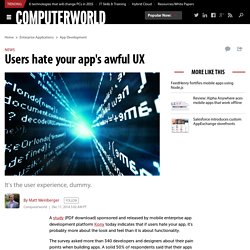

UI Stencils.
Références. Logiciels. It's your clients' fault that users hate your app's awful UX. A study (PDF download) sponsored and released by mobile enterprise app development platform Kony today indicates that if users hate your app, it's probably more about the look and feel than it is about functionality.

The survey asked more than 340 developers and designers about their pain points when building apps. A solid 50% of respondents said that their apps weren't approved by higher-ups or their outside clients because of user experience (UX) issues, not because of problems with functionality. "Mobile app design is often overlooked in the development process, but companies are finding that most mobile apps fail because of lack of user adoption caused by poor design and experience," said Kony Executive Vice President and CMO Dave Shirk in a statement. As for the designers best able to improve the situation, they said that working with developers is a huge pain.
When a prototype app comes back to them, they said they provide input and guidance, but collaboration is a real challenge. The Guide To UX Design Process & Documentation - Part 1. In this article, we explain the general product design process and relevant documents you might produce at the first three of seven stages.

It is meant to be a flexible framework as opposed to a strict recipe. These ideas are covered in greater detail across 150+ pages in the Guide to UX Design Process & Documentation e-book. The following is an overview of product design and development documentation, constituent elements, and the respective phases to which they belong. The development process and resulting documents can vary widely between companies, as many follow their own unique design and development principles/methodology.
In general, however, many of the deliverables below are common within most organizations in some form—including my wireframing and prototyping company, UXPin. How They All Relate 1. 2. 3. 4. 5. 6. 7. 1. Initial activities such as stakeholder’s kickoff meeting, brainstorming, and rudimentary product sketching lead to the creation of the following outputs: The Guide to UX Design Process & Documentation (Part 2) In this article, we explain the general product design process and relevant documents you might produce at the first three of seven stages.

It is meant to be a flexible framework as opposed to a strict recipe. These ideas are covered in greater detail across 150+ pages in the Guide to UX Design Process & Documentation e-book. The following is an overview of product design and development documentation, constituent elements, and the respective phases to which they belong. The development process and resulting documents can vary widely between companies, as many follow their own unique design principles/methodologies. In general, many of the deliverables below are common within most organizations in some form—including UXPin. In Part 1, we covered the first three steps of the UX Design process.
How They All Relate: The 7 Steps to the UX Design Process. When to Use Which User Experience Research Methods.
Architecture de l'information. La conception participative: concevoir avec les utilisateurs[ Usaddict: Ressources sur l’ergonomie des interfaces (le blog Usabilis)] La conception participative est une méthode où l’utilisateur final d’un site web ou d’une application collabore de manière active à la conception.
![La conception participative: concevoir avec les utilisateurs[ Usaddict: Ressources sur l’ergonomie des interfaces (le blog Usabilis)]](http://cdn.pearltrees.com/s/pic/th/participative-utilisateurs-94037597)
Cette méthode permet à travers de nombreux ateliers de faire travailler ensemble les utilisateurs et les UX designers. Ces ateliers de co-conception peuvent porter sur l’analyse du besoin et donc la définition des fonctionnalités, ou la conception de maquettes. Cette étroite collaboration entre utilisateurs et UX designers permet de comprendre les attentes tacites des utilisateurs et favorise une meilleure adoption des interfaces conçues. Introduction La méthode de conception centrée utilisateur est une démarche bien établie au sein de la communauté UX.
Cette démarche est itérative et se déroule en trois grandes phases avant, pendant et après la réalisation des interfaces : analyse, conception, évaluation. Les méthodes de la phase d’analyse et d’évaluation sont bien établies : études terrain, audits, tests utilisateur, etc. Future workshop.
Personas. Card sorting. Design interface. Le métier.